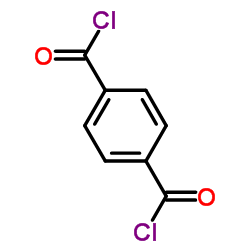Biodegradable poly(terephthalate-co-phosphate)s: synthesis, characterization and drug-release properties.
Hai-Quan Mao, Irina Shipanova-Kadiyala, Zhong Zhao, Wenbin Dang, Angela Brown, Kam W Leong
Index: J. Biomater. Sci. Polym. Ed. 16(2) , 135-61, (2005)
Full Text: HTML
Abstract
To develop biodegradable polymers with favorable physicochemical and biological properties, we have synthesized a series of poly(terephthalate-co-phosphate)s using a two-step poly-condensation. The diol 1,4-bis(2-hydroxyethyl) terephthalate was first reacted with ethylphosphorodichloridate (EOP), and then chain-extended with terephthaloyl chloride (TC). Incorporation of phosphate into the poly(ethylene terephthalate) backbone rendered the co-polymers soluble in chloroform and biodegradable, lowered the Tg, decreased the crystallinity and increased the hydrophilicity. With an EOP/TC molar feed ratio of 80: 20, the polymer exhibited good film-forming property, yielding at 86.6 +/- 1.6% elongation with an elastic modulus of 13.76 +/- 2.66 MPa. This polymer showed a favorable toxicity profile in vitro and good tissue biocompatibility in the muscular tissue of mice. In vitro the polymer lost 21% of mass in 21 days, but only 20% for up to 4 months in vivo. It showed no deterioration of properties after sterilization by gamma-irradiation at 2.5 Mrad on solid CO2. Release of FITC-BSA from the microspheres was diffusion-controlled and exceeded 80% completion in two days. Release of the hydrophobic cyclosporine-A from microspheres was however much more sustained and near zero-ordered, discharging 60% in 70 days. A limited structure-property relationship has been established for this co-polymer series. The co-polymers became more hydrolytically labile as the phosphate component (EOP) was increased and the side chains were switched from the ethoxy to the methoxy structure. Converting the methoxy group to a sodium salt further increased the degradation rate significantly. The chain rigidity as reflected in the Tg values of the co-polymers decreased according to the following diol structure in the backbone: ethylene glycol > 2-methylpropylene diol > 2,2-dimethylpropylene diol. The wide range of physicochemical properties obtainable from this co-polymer series should help the design of degradable biomaterials for specific biomedical applications.
Related Compounds
| Structure | Name/CAS No. | Molecular Formula | Articles |
|---|---|---|---|
 |
Terephthaloyl Chloride
CAS:100-20-9 |
C8H4Cl2O2 |
|
Synthesis and evaluation of chloramphenicol homodimers: mole...
2015-01-01 [PLoS ONE 10 , e0134526, (2015)] |
|
Synthesis of polymer-type chiral stationary phases and their...
2007-02-01 [Chirality 19(2) , 129-40, (2007)] |
|
Polyamide microcapsules containing jojoba oil prepared by in...
2005-08-01 [J. Microencapsul. 22(5) , 471-86, (2005)] |
|
Comparative evaluation of lesion development, tissue damage,...
2014-12-01 [J. Microencapsul. 11(2) , 213-24, (1994)] |
|
Study of albumin and fibrinogen membranes formed by interfac...
2010-09-01 [Biofabrication 2(3) , 035002, (2010)] |